Offensive linemen often don’t get the recognition they deserve because it’s a difficult position to evaluate — one without readily available statistics to pull up in seconds. That's why the PFF play-by-play grading gives us a unique perspective regarding offensive line play, as it separates the play of the offensive line from the play of the quarterback it is protecting or the runner it is blocking for.
Using those grades as a guide, this is where each team’s offensive line stacked up during the 2020 regular season, with the important caveat that this list is meant to reflect how each group played this season rather than serve as a projection of future performance or talent.
1. Cleveland Browns
This is the culmination of an offseason dedicated to improving the offensive line and improving players such as Wyatt Teller who were already in Cleveland. The Browns closed the 2019 regular season ranked 23rd on this same list, and we jumped them to sixth in the league entering the 2020 season following the additions of Jedrick Wills Jr. in the first round of the 2020 NFL Draft and Jack Conklin in free agency.
Those two additions bolstered the weakness that the Browns had at tackle in 2019, particularly at right tackle. Conklin ended the 2020 season as the highest-graded right tackle in the league at 84.3 overall, and he was the only right tackle in the NFL to allow a pressure rate below 3.0% on 250 or more pass-blocking snaps (2.9%).
The biggest surprise on the line, though, was the man to Conklin’s left — Wyatt Teller at right guard. Teller's 92.9 PFF grade on the year also led his position, and it served as a massive year-over-year improvement from the 56.7 overall grade we saw from him in 2019. No guard earned a positive grade on a higher percentage of his run-blocking snaps than Teller did.
Offensive line coach Bill Callahan deserves a lot of credit for the job he has done with this group this season.
2. Green Bay Packers
Over recent times, the Packers’ offensive line has consistently been one of the league's best pass-protecting units, but their collective effort this season was made more impressive by the way they were able to deal with injuries to key starters like Corey Linsley — PFF’s highest-graded center — among others.
No one player highlights the group's adaptability more than Elgton Jenkins, who saw at least 25 snaps at his natural left guard position, center, left tackle and right tackle this season while still grading at an above-average level overall. Unfortunately for the Packers, Jenkins may have to be called on once again to play out of position at left tackle for the injured David Bakhtiari in the postseason.
This line takes a big hit without Bakhtiari out there, but they still have pieces to be an effective group in the postseason.
3. Los Angeles Rams
It is safe to say that the Rams got the bounce-back season they badly needed from their offensive line following the disaster that was the 2019 season for Los Angeles up front.
There really wasn’t a whole lot of movement from the Rams this past offseason to add to the group, so the change centered around improvement from the players who were already on the roster. Andrew Whitworth improved his PFF grade by 16 points before his injury, while Austin Blythe’s and Austin Corbett’s grades each jumped nearly 20 points. Those improvements paled in comparison to Rob Havenstein’s jump from a 50.9 PFF grade in 2019 to 80.0 heading into this year’s postseason.
As a result, Jared Goff has been pressured on fewer than 30% of his dropbacks after that number sat at 36% in 2019. That remains one of the biggest keys to this offense moving forward, given Goff's career clean pocket vs. pressure splits.
4. New England Patriots
You don’t expect rookie offensive linemen to come into the NFL and play the way Michael Onwenu did for the Patriots, especially rookie guards who were selected in the sixth round and forced into a starting job at tackle.
That didn’t stop Onwenu from slotting in as a top-10 right tackle in the NFL by PFF grade in addition to strong play at both left guard and right guard at various points in the season.
The New England offense didn’t have a whole lot going for it in 2020, but the offensive line is an area that they can count as a strength on that side of the football. It’s a group that could be dealt a big loss in the form of Joe Thuney, however. Thuney ended the season as the sixth-highest-graded left guard in the NFL and will be a free agent this offseason.
5. Tampa Bay Buccaneers
Tom Brady has been under pressure on just 24% of his dropbacks this season — fourth lowest in the NFL — despite operating in a Bruce Arians offense that traditionally brought pressure on its quarterbacks due to the emphasis on the downfield passing game. Part of the credit for that should go to Brady himself, but the guys up front deserve some love, as well.
In particular, rookie right tackle Tristan Wirfs has played at an All-Pro level in his first season in the NFL, which is a real rarity for rookie offensive linemen. Wirfs' 82.2 PFF grade ranks second at the right tackle position, and he has proven himself against some of the best edge defenders in the league — a list that includes the likes of Cameron Jordan, Khalil Mack and Joey Bosa.
Wirfs and left guard Ali Marpet serve as the cornerstones for what should be one of the best offensive lines in the NFL moving forward.
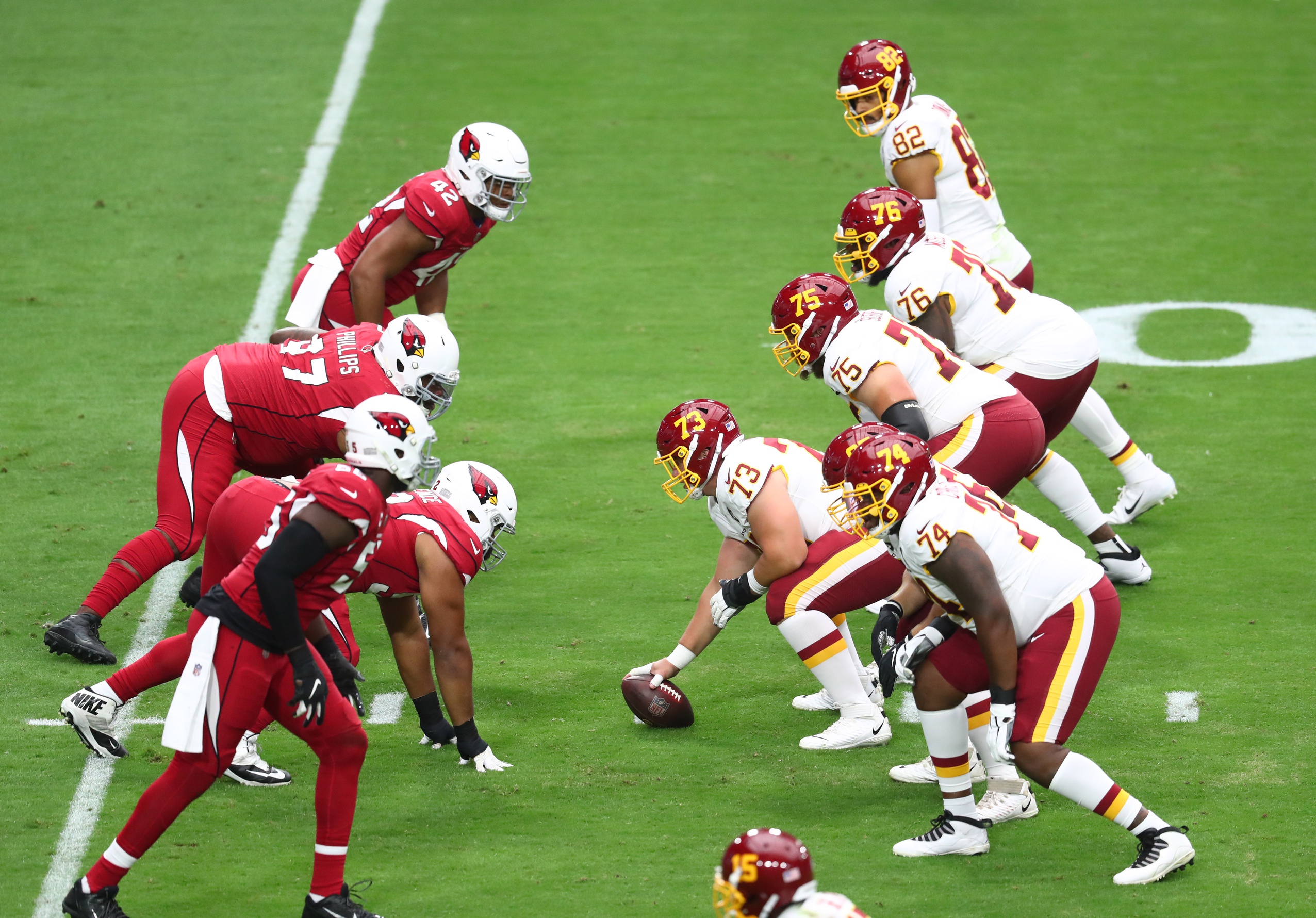
6. Washington Football Team
Coming in at 29th on the preseason edition of these rankings, Washington presents one of the biggest surprises of the regular season with their play up front.
The biggest question mark coming into the year surrounded who would win the left tackle job. Geron Christian won the job and started there for six games before being placed on injured reserve with a knee injury. Still, his replacement, Cornelius Lucas, actually provided some stability at the position with a 78.3 overall grade and an 83.1 grade in pass protection that ranked 11th at the position over the regular season.
Solid play from Lucas and Wes Schweitzer on the left side, paired with top-10 grades from each of Chase Roullier, Brandon Scherff and Morgan Moses at the other starting spots, resulted in a much-improved group from a season ago. Roullier recently got his long-term extension to stay in Washington, and Scherff will be looking for the same this offseason.
7. Indianapolis Colts
This was a relatively down year for the Colts’ offensive line, given some late-season injuries at the tackle position and middling performances from several players on the interior, but the fact that they remain at No. 7 speaks to what we have come to expect from this unit.
Quenton Nelson’s first two seasons in the NFL were so remarkable that an 86.1 overall grade in 2020 — third among qualifying left guards — feels like a bit of a letdown. We can’t be that quick to normalize greatness, though. Nelson’s 90.6 PFF grade over the first three seasons of his career ranks first among all guards since 2018, and it is neck and neck with the grade Zack Martin produced over the first three seasons of his career in Dallas (90.8). Nelson has given no reason to believe that he won’t be one of the best interior offensive linemen in the NFL for the next decade-plus.
8. New Orleans Saints
The Saints have a strong claim to owning the best tackle duo in the NFL. Terron Armstead at left tackle and Ryan Ramczyk at right tackle are both forces in the run game as well as in pass protection. That shows in the pressure numbers allowed for both players since Ramczyk entered the league in 2017. Over that four-year stretch, Armstead’s pressure rate allowed of 3.7% is tied for the best mark at left tackle, and Ramczyk’s rate of 4.0% sits in third at the right tackle position among players with at least 1,000 pass-blocking snaps.
Those two are having another strong year on the outside for the Saints, but the reason they aren’t higher on this list is the play they’ve got from their guards in 2020. Andrus Peat (58.8 pass-blocking grade), Cesar Ruiz (43.4 pass-blocking grade) and Nick Easton (46.6 pass-blocking grade) have all allowed far too much interior pressure this season. That position has held back an offensive line that does have several really strong pieces despite the Saints’ efforts to address the interior this offseason.
9. San Francisco 49ers
It was difficult to be 100% certain about what Trent Williams would look like after the injuries and time off, but he quickly made it clear that this was still the same guy who was perennially in the conversation for being the best left tackle in the NFL. In fact, Williams’ 91.9 PFF grade during the 2020 regular season was the best mark by any left tackle in the league.
His size and athleticism allow him to do things in the run game that most tackles simply can’t, and that was apparent again in San Francisco this season despite all the injuries they suffered.
For all those injuries, the offensive line was able to stay relatively healthy outside of the center position, where each of Daniel Brunskill, Ben Garland and Hroniss Grasu played 200 or more offensive snaps. The interior offensive line could be an area that the 49ers look to upgrade this offseason, but all in all, it was an impressive showing for the offensive line this season.
10. Buffalo Bills
The offensive line is just one example of how the Bills have done a tremendous job of building the right way around a young quarterback. They didn’t throw a lot of high-value resources at the offensive line, but they did take a fair amount of chances on players in free agency and continued to bring in guys who could contribute and eliminate areas of weakness.
A good example of that is right tackle Daryl Williams, who earned a 79.4 grade for Buffalo this season. Williams had a strong year at right tackle with the Panthers in 2017, but an injury-shortened 2018 campaign followed by a down year in 2019 across all four guard and tackle positions allowed the Bills to take a chance on Williams in free agency on just a one-year, $2.25 million contract. It’s safe to say that contract has paid off for Buffalo.
11. Kansas City Chiefs
Any time you can lose one of the best offensive linemen in the NFL for over half the season and keep your head above water as an offensive line, that’s not a bad result. That’s what we’ve seen from the Chiefs this season, with right tackle Mitchell Schwartz missing every game since Week 6 with a back injury. His replacement, Mike Remmers, has fared admirably in pass protection in his stead. Remmers’ pressure rate allowed of 4.4% this season would be his lowest mark at the tackle position since 2014.
The Chiefs’ offensive line can be made out to look worse than it is in pass protection because of the way Patrick Mahomes plays the position and the deeper drops he takes. In fact, a position-high 53 pressures were charged to Mahomes himself over the course of the regular season. It’s something that the Chiefs will gladly live with because of the plays that Mahomes can make and the way he avoids negative plays, but it’s something to keep in mind when evaluating the offensive line.
12. Arizona Cardinals
The Cardinals had their share of issues along the interior of their offensive line, but considering where this group was coming from back in the 2018 season — one of the worst offensive lines in recent memory — a 12th-place finish here doesn’t look all that bad.
The tackle duo of D.J. Humphries at left tackle and Kelvin Beachum on the right side held up well in pass protection throughout the year, with both players recording pass-blocking grades north of 75.0. In particular, Humphries justified the big extension the Cardinals gave him this offseason with an 88.3 overall grade that paired the improvement he showed in pass protection in 2019 with the stronger run blocking that he showcased earlier in his career. He joined Trent Williams as one of two left tackles to post a run-blocking grade above 90.0 this season (90.9).
13. Detroit Lions
Another year, another season of improved play from Frank Ragnow, who is asserting himself as one of the league’s top young interior offensive linemen. His 80.3 PFF grade in 2020 ranked second at the center position, and it came behind career-high grades both in pass protection and as a run-blocker. The fact that he played through a fractured throat late in the season only adds to the notion that this is a guy you don’t want to mess with in the trenches.
There were shuffling pieces along the line this season, but the play from both Ragnow and left tackle Taylor Decker (82.0 PFF grade) fresh off a contract extension this offseason helped stabilize the group. The Lions will be hoping for a second-year jump for Jonah Jackson at guard in 2021 to help take the unit to the next level.
14. Seattle Seahawks
The Seahawks’ offensive line ranked 16th as a unit in pass-blocking grade this season. That may not appear all that impressive on the surface, but it’s the highest they’ve ranked in that area since Russell Wilson has been in Seattle.
That improvement is due in part to several members along the line taking steps toward the production Duane Brown has been able to put forth each year since joining the team in 2017.
Brown remains the leader of that group up front at 35 years old, fresh off his highest PFF grade (87.3) since 2011. He has been a model of consistency in pass protection over the years, with pass-blocking grades of 77.0 or higher in every season since 2011 on at least 400 pass-blocking snaps. The 2020 season was just another chapter in what has been an underrated career for the 2008 first-round pick.
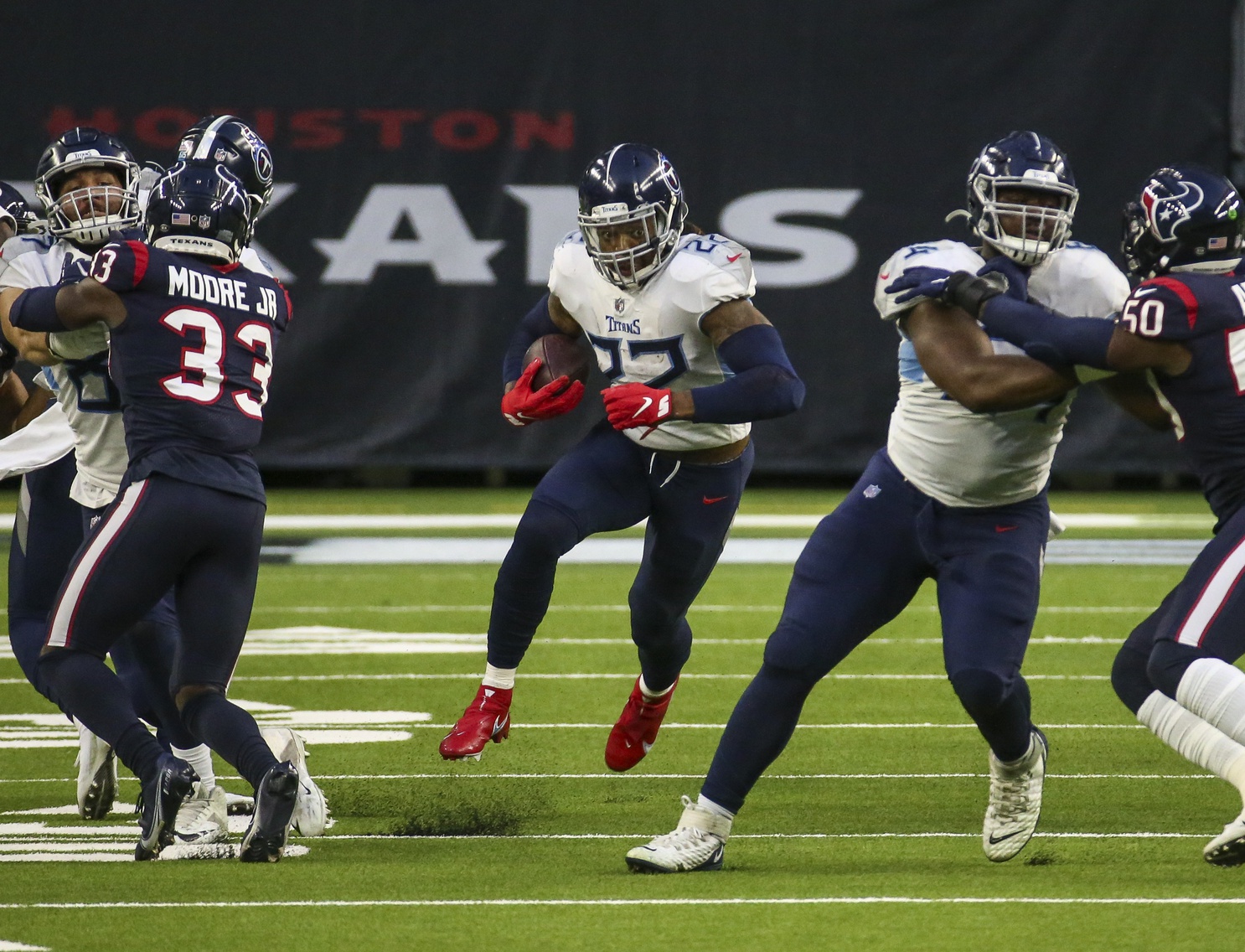
15. Tennessee Titans
The Titans as a whole were a much better run-blocking than pass-blocking group; there was not a single starter on the Tennessee offensive line that recorded a higher pass-blocking than run-blocking PFF grade.
Derrick Henry being the first-team All-Pro running back obviously played a role in their rushing success this season, but the guys up front also did a good job of blocking for one of the more interesting run schemes in the NFL. The Titans ran more outside zone (45%) than any team other than the Bears, but many of their better runs of the season came in duo.
The tackle position was the biggest concern for the Titans this season, with off-the-field troubles putting a sizable blemish on the rookie season of first-round pick Isaiah Wilson and an injury to Taylor Lewan compounding the loss of Jack Conklin on the other side in free agency. Those are big contributing factors to some of Tennessee’s struggles in pass protection this year.
16. Baltimore Ravens
Losing Marshal Yanda to retirement in the offseason and Ronnie Stanley to injury midway through the 2020 season isn’t going to come without its struggles. Those were two of the better players in the NFL at their respective positions in 2019 and a big reason why the Ravens had one of the best offensive lines in the league.
Baltimore has dealt with plenty of moving pieces beyond those two losses, as well. Nine different offensive linemen played at least 100 offensive snaps throughout the regular season — the same number as some of the more beat-up offensive lines in the league like Philadelphia and Dallas.
All things considered, a middle-of-the-pack finish given that upheaval is not the worst of outcomes, and it’s an offensive line and offense that seems to be finding their rhythm heading into the postseason.
17. Pittsburgh Steelers
The Steelers’ offensive line has been an interesting case this season. Going purely off pressure rate allowed, they’ve been the best pass-protecting unit in the NFL, with Ben Roethlisberger being pressured on a league-low 21% of his dropbacks this season. The important footnote there is that Roethlisberger is also getting rid of the football quicker than any quarterback we’ve charted since 2012 (2.17 seconds on average). The PFF grades are built to factor that in, however, and Pittsburgh’s offensive line still finished the regular season ranked fourth in pass-blocking grade.
A 31st-ranked run-blocking unit is what drops them to 17th on this list. The only starting offensive lineman with a run-blocking grade north of 60.0 is Alejandro Villanueva at 60.9, and that shows in their rushing success on the year. No team averaged fewer yards per run play (3.6) than the Steelers did this year. It’s a group that could use an injection of youth and talent this offseason.
18. Carolina Panthers
The Panthers haven’t had any disastrous efforts along the offensive line this season, but they also don’t have all that many players to highlight. The clear choice for the best player along their line this season is right tackle Taylor Moton, who enters the offseason as an unrestricted free agent along with the majority of the Panthers’ starters on the line.
Moton has delivered three straight seasons of quality play as the starting right tackle for Carolina, but his career-high PFF grade of 81.2 this season — third among qualifying right tackles — came thanks to his run-blocking grade catching up to what he’s been able to do in pass protection throughout his career. Moton’s 76.3 run-blocking grade in 2020 was nearly 10 points higher than his previous career-high mark of 67.4 in 2019.
19. Philadelphia Eagles
The Eagles’ offensive line went through the wringer this past season, as they were trotting out a new starting five up front seemingly every week due to injury. Those injuries all came after they lost projected starting left tackle Andre Dillard and right guard Brandon Brooks to injury before the season began. Eleven different offensive linemen played at least 50 snaps for Philadelphia this season. It’s going to be nearly impossible for any offensive line to lose all that talent and still produce at a high level.
That said, the Eagles weren’t one of the worst offensive lines in the NFL with their makeshift group. Jason Kelce was the lone consistent presence at center for the team, and he ended the season with the third-highest run-blocking grade of any center in the league. That’s an area he has always excelled in with his ability to use his athleticism and get out in the open field.
The Eagles will hope that 2021 brings some more stability, giving whoever is back at quarterback for the offense a few more clean pockets to work from.
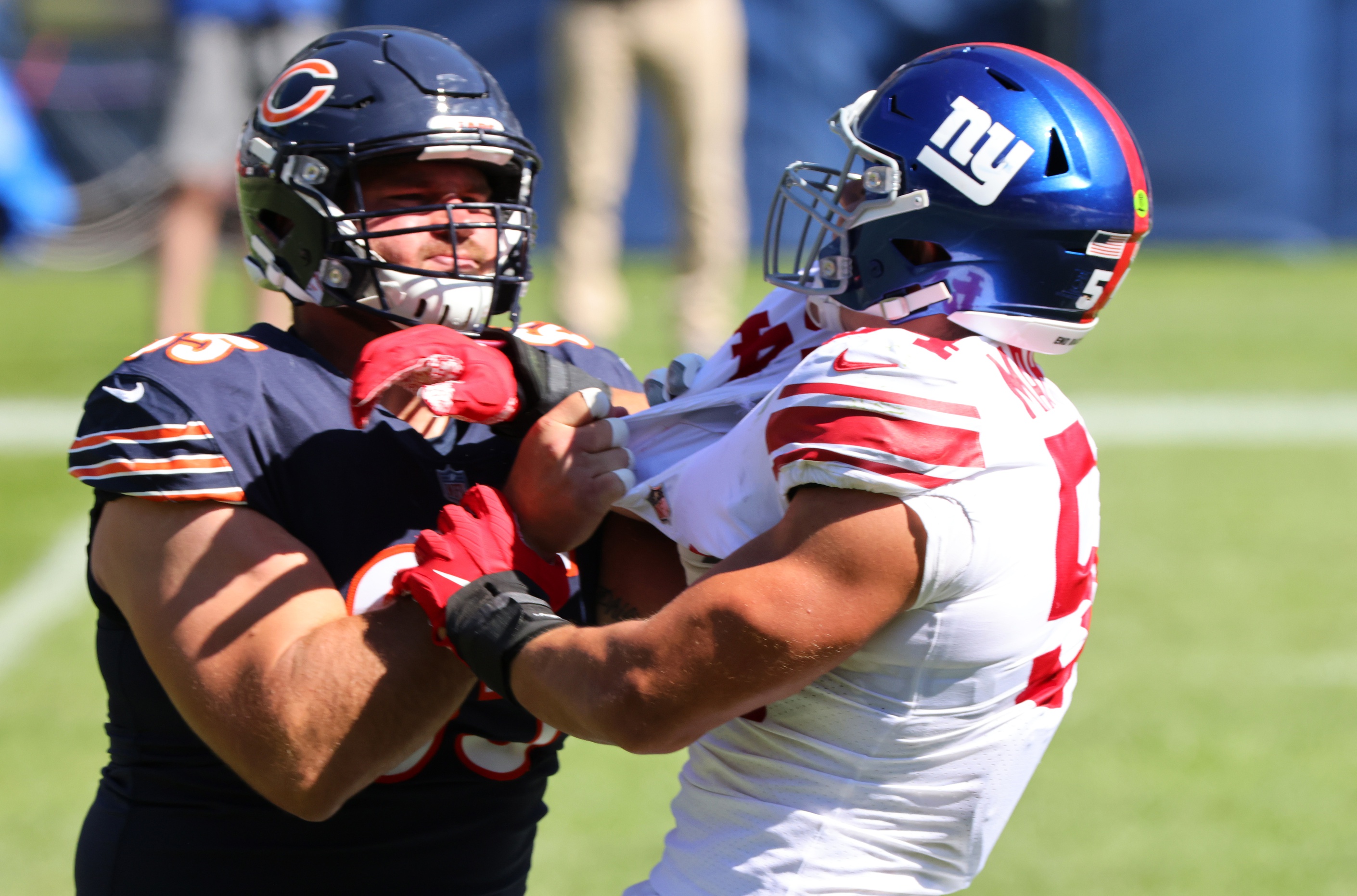
20. Chicago Bears
There’s an argument to be made that no offensive lineman finished the season hotter than Cody Whitehair did after moving over from center to left guard in Week 12. His 88.9 overall grade from Week 12 through the end of the season ranked third among all offensive linemen behind Quenton Nelson and Trent Williams. That run followed a string of four consecutive starts at center with a pass-blocking grade below 30.0.
It creates an interesting situation for the Bears this offseason with James Daniels — the team’s starting left guard at the beginning of the season — returning from injury. There is a chance he could bump over to right guard at a spot that saw Germain Ifedi and Alex Bars both grade in the mid-60s this season. It would not be surprising to see the Bears address the interior line this offseason, either.
21. Atlanta Falcons
The Falcons allocated not one but two first-round picks toward improving the right side of their offensive line in the 2019 NFL Draft. Things didn’t quite pan out in Year 1 for those players, as Chris Lindstrom played just 309 offensive snaps — missing significant time with injury — and Kaleb McGary was routinely beat in pass protection with 13 sacks and 13 quarterback hits allowed in 2019.
Fast forward to 2020 and Lindstrom is the highest-graded offensive lineman in Atlanta with a 77.1 overall grade (fifth at right guard) and more offensive snaps than any other player at the position. However, McGary still had his struggles in pass protection with a 58.2 pass-blocking grade this season. He’ll need to show signs of improvement there in 2021 to maintain his starting job.
22. Jacksonville Jaguars
The tackle position remains one that Jacksonville needs to address this offseason, with both Cam Robinson and Jawaan Taylor earning overall grades below 62.0 in 2020. This marks the third consecutive full season of disappointing play from Robinson, but the bigger letdown for the Jaguars had to have been what they got out of Taylor in his second season out of Florida. The former second-round pick took a sizable step back in pass protection from what he was able to showcase as a rookie, seeing his PFF pass-blocking grade fall from 69.0 in 2019 to 51.8 this season.
The Jaguars have several high-level pass protectors in Brandon Linder and Andrew Norwell on the interior. Still, you don’t want to go into Trevor Lawrence’s first season in Jacksonville without any starting options that you feel good about at tackle.
23. Houston Texans
A lot of things had to go poorly for the Texans for them to get the kind of season they did out of Deshaun Watson at quarterback yet still finish with four wins on the season. The offensive line fell into that category of things that did not go according to plan.
They were the 30th-ranked run-blocking group in the NFL, and the only real bright spot was Laremy Tunsil at left tackle, who was once again one of the better pass-protecting left tackles in the NFL, earning his second consecutive pass-blocking grade of 85.0 or higher.
The Texans don’t make things easy on their offensive linemen in the passing game with play action, bootlegs or screens, which means that there is a lot of what we call “true pass sets” for players like Tunsil throughout a season, and no player graded better on that subset of plays than he did. It’s a good thing that he is playing well, at least because the number three overall pick in the 2021 NFL Draft is heading to Miami as part of the trade that acquired him.
24. Las Vegas Raiders
Injuries to Richie Incognito (74 snaps this season) and Trent Brown (282 snaps) really did a number to an offensive line that has talent. Incognito’s spot at left guard was manned by a combination of Denzelle Good and John Simpson, neither of whom reached a PFF pass-blocking grade of 50.0 on the season. Right tackle was held down by a combination of Sam Young, Brandon Parker and Good when Brown wasn’t on the field. Those three earned PFF grades of 59.2, 47.5 and 57.8, respectively. Those two holes hurt the Raiders significantly in 2020.
One bright spot moving forward is Kolton Miller, who has taken real strides in pass protection every season in the NFL to this point. His 81.3 pass-blocking grade this year is nearly a 30-point upgrade on what he was able to produce as a rookie in 2018 (52.7).
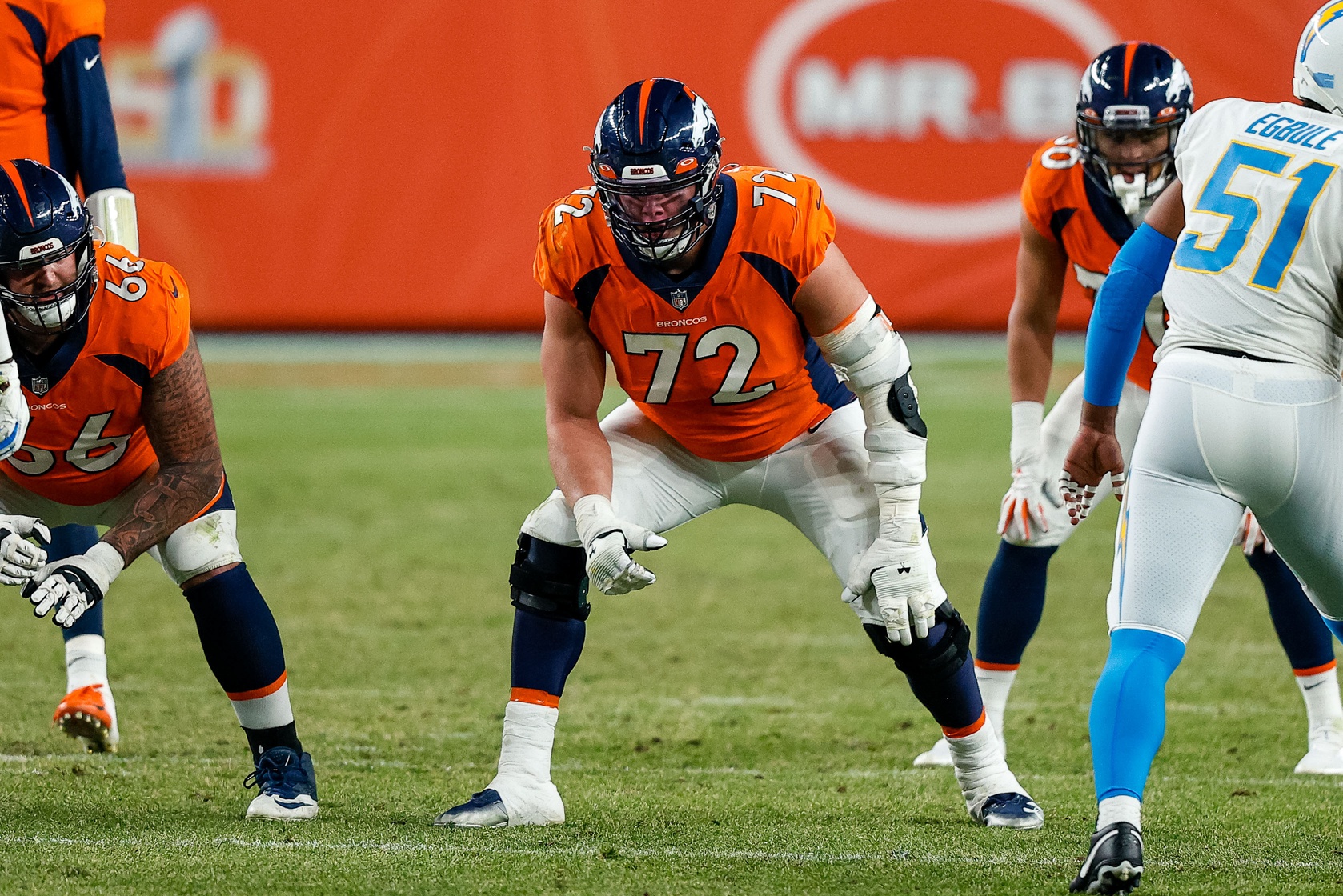
25. Denver Broncos
Garett Bolles’ ascent to grading out as one of the best tackles in the NFL came as one of the bigger surprises when looking at offensive line play this season. It’s hard to think that a reduction in holding penalties being called across the NFL didn’t play some role in his breakout, but it was an impressive season for the fourth-year man out of Utah nonetheless — a season that earned him a fresh, four-year contract extension with the team.
Unfortunately for Denver, other pieces along the line didn’t come close to meeting Bolles’ level of play. Rookie center Lloyd Cushenberry got off on the wrong foot with 15 pressures allowed in his first four NFL games and ended the year as PFF’s lowest-graded center among qualifiers. Elijah Wilkinson produced just a 52.4 grade at the right tackle position in the second consecutive season that the Broncos missed right tackle Ja’Wuan James, as well.
James’ expected return in 2021, along with some improvement from young players like Cushenberry and Dalton Risner on the interior, should lead to a better effort from the line next season.
26. Minnesota Vikings
The offensive line has been an issue for multiple years now in Minnesota, and it remains one following a 2020 season where they graded out as the 28th-best pass-blocking offensive line in the NFL. Once again, it was the interior of the offensive line where most of the issues popped up.
Ezra Cleveland’s 6.9% pressure rate allowed ranked 37th out of 40 qualifying right guards in his first year at guard after starting three seasons as Boise State’s left tackle. In that same vein, Garrett Bradbury’s 5.1% pressure rate allowed ranked 34th out of 36 qualifying centers, and Dakota Dozier’s pressure rate allowed of 8.0% ranked 36th out of 39 qualifying left guards. None of their three starters on the interior cracked the top 32 at their respective position.
That’s a problem, and it’s one the Vikings will have to deal with this offseason.
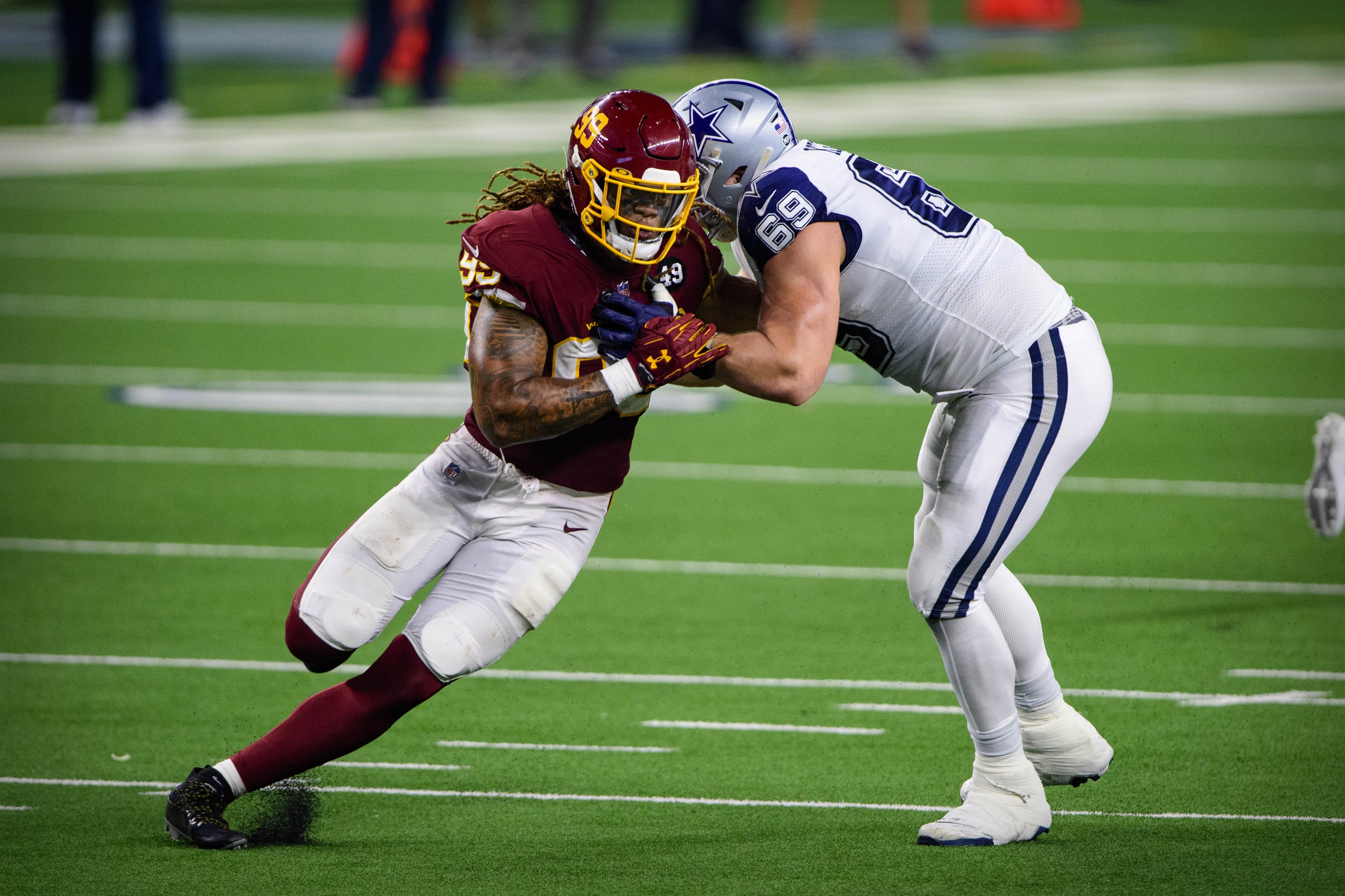
27. Dallas Cowboys
The Cowboys’ three best offensive linemen played 618, 154 and 0 snaps this season, respectively; they were another team that was blasted with injuries to key starters such as Zack Martin, Tyron Smith and La’el Collins. As such, their offensive line play in 2020 wasn’t an accurate representation of the talent they have on the roster.
Dallas struggled to replace Smith and Collins at the tackle position, in particular. Cowboys tackles combined to post a 57.2 pass-blocking grade on the year, beating out only the Giants to avoid the worst mark in the NFL. Brandon Knight and Terence Steele especially struggled to hold up, as both allowed pressure rates north of 7% for the season.
The Cowboys will be hoping to stay healthy both along the offensive line and at quarterback in 2021 to realize the offensive potential that everyone expected them to run with this season.
28. Miami Dolphins
Few teams invested more in improving the offensive line than the Dolphins did entering the 2020 season. They spent draft picks on Austin Jackson in the first round, Robert Hunt in the second round and Solomon Kindley in the fourth round — all of whom played at least 700 offensive snaps this season.
Additionally, Miami brought in players such as Ereck Flowers and Ted Karras in free agency in an attempt to sure up the interior. To be fair, the Dolphins were improved along the offensive line this season, but they set the bar so low in 2019 that this was still one of the worst offensive lines in the NFL.
It’s to be expected that an offensive line running out three rookies — particularly ones who were considered projects like Jackson was — would take their lumps early on, and the Dolphins have. Hunt did provide some optimism late in the year at right tackle, though, as his 76.4 PFF grade from Week 12 through the end of the season ranked fifth out of 37 qualifying right tackles.
29. New York Jets
The Jets, like the Dolphins, threw a lot of resources at the offensive line this offseason. That included a first-round pick spent on Louisville tackle Mekhi Becton, who impressed in his rookie season. His 74.3 PFF grade ranked 19th out of 38 qualifying left tackles despite battling injuries, and he showcased that his rare blend of size and athleticism could cause serious problems for defenders.
Overall, however, it was a disappointing season for the offensive line in New York. They allowed pressure in 2.5 seconds or less on 28% of their dropbacks — the worst rate in the NFL. The line wasn’t creating many lanes in the run game, either. The Jets averaged just 1.1 yards per carry before contact per rushing attempt in 2020 (30th). Once again, they’ll have to look to add pieces to their offensive line this offseason.
30. Cincinnati Bengals
It’s safe to say that Joe Burrow did not have the cleanest of pockets to work from in his rookie season before suffering a season-ending injury in one of those collapsing pockets. The No. 1 overall pick in the 2020 NFL Draft took 32 sacks (t-2nd most) and 42 quarterback hits (t-5th most) over the first 11 weeks of the season. That falls back largely on the play of the offensive line.
Jonah Williams was the only member of Cincinnati’s offensive line to record a pass-blocking grade of 70.0 or higher (75.8) in a group that was hampered not only by a lack of talent but also by injuries. Ten different players played at least 200 snaps along the offensive line for the Bengals this season. It’s not a surprise that many Cincinnati fans have their sights set on Oregon tackle prospect Penei Sewell in the 2021 NFL Draft.
31. New York Giants
With one year in the books, the Giants can’t be feeling good about their decision to take Andrew Thomas as the first tackle off the board in last year’s draft, given the season he had compared to the tackles selected after him. Thomas allowed 57 pressures at left tackle this season, 14 more than any other player at the position. He was the only player at the position to be charged with 10 sacks allowed, as well.
As you could guess for a team coming in at second to last on this list, Thomas wasn’t the only problem up front for the Giants. Shane Lemieux and Will Hernandez both allowed pressure rates of at least 8% at left guard, while Cameron Fleming — filling in for the opted-out Nate Solder — allowed the sixth most pressures in the league at the right tackle position.
32. Los Angeles Chargers
The Chargers’ offensive line has been among the worst in the NFL for several years now, but they were supposed to be better this season after adding veterans Trai Turner and Bryan Bulaga to the right side of the line. At least, they were supposed to be better in theory — that’s not what played out on the field.
Turner and Bulaga both battled through injury-shortened seasons and weren’t effective when they were on the field, either. Bulaga’s 61.6 overall grade ranked 29th at the right tackle position, and Turner came in as the lowest-graded right guard in the entire league by a wide margin (34.8). Those were the veterans who were supposed to raise the floor of what was otherwise a bad unit coming into the year, which made the lack of production from those two players hurt all the more.
Storm Norton came out of the year as Los Angeles’ highest-graded offensive lineman at 65.1 overall. In other words, the offensive line is once again a need for the Chargers.
More of PFF's postseason rankings
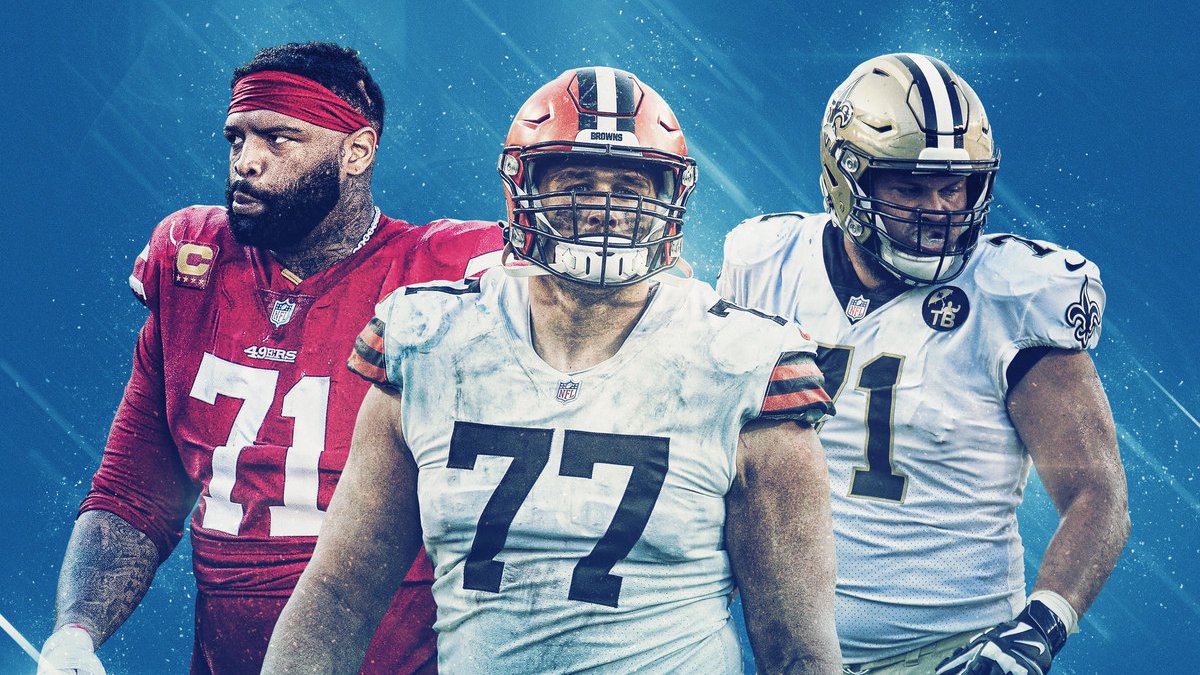



 © 2025 PFF - all rights reserved.
© 2025 PFF - all rights reserved.